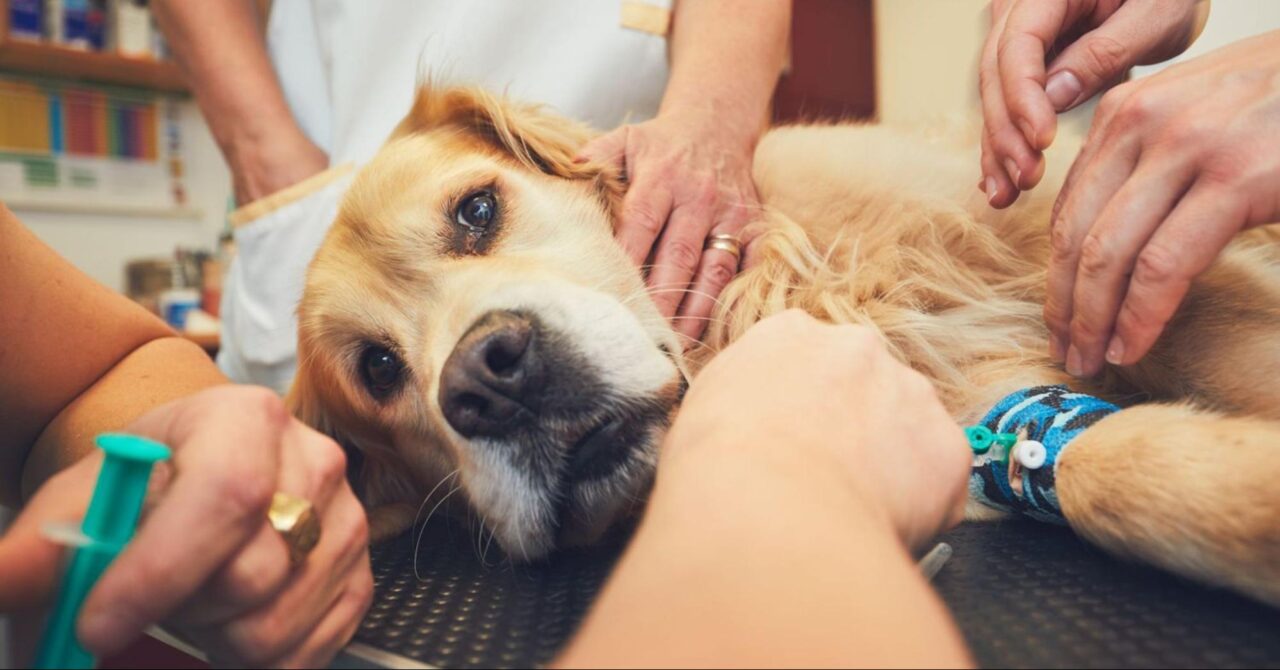Euthanasia is a humane and compassionate option for pets suffering from terminal illnesses like cancer. It involves painlessly ending a pet’s life to prevent further suffering. We’ll explain to you how to determine the right time for when to euthanize a dog with cancer.

When to Euthanize a Dog with Cancer
Cancer in dogs is a heartbreaking reality many pet owners face. Knowing when to consider euthanasia for a beloved dog diagnosed with cancer is a difficult decision that requires careful thought and compassion.
Understanding Cancer in Dogs
Cancer can affect dogs of any age or breed. Common types include lymphoma, osteosarcoma, and mammary gland tumors. Symptoms vary but can include lumps, weight loss, and changes in behavior.
Diagnosis and Treatment Journey
Receiving a cancer diagnosis for your dog can be devastating. Dogs can develop various types of cancer, such as lymphoma, osteosarcoma, or mast cell tumors. Treatment options like surgery, chemotherapy, or radiation therapy may be available, but they come with challenges such as side effects and financial costs.
Quality of Life Considerations
As a pet parent, assessing your dog’s quality of life becomes paramount. Notice how cancer affects your dog’s ability to enjoy daily activities like eating, walking, or playing. Monitor both physical and emotional health to gauge well-being accurately.
Discussing with Your Veterinarian
Your veterinarian plays a crucial role in guiding you through this journey. They can provide insights into prognosis and treatment outcomes, aiding in making informed decisions aligned with your dog’s best interests.
Recognizing Signs of Suffering
Look for signs of pain or discomfort in your dog. Changes in behavior, appetite, or mobility may indicate worsening conditions. Pay attention to your intuition and observations.
Making the Decision
Deciding when to euthanize requires thoughtful consideration. Factors such as pain level, treatment response, and overall well-being need evaluation. Be emotionally prepared for this heartrending choice.
Euthanasia Process
When the time comes, understanding the euthanasia process is crucial. Your veterinarian will ensure a peaceful transition for your dog, allowing you to be present during this final act of love.
Dealing with Grief and Loss
Experiencing grief is a common and instinctual reaction to the loss of a beloved pet. Explore coping strategies like memorializing your dog or seeking support from friends, family, or pet loss counselors.
Honoring Your Dog’s Memory
Create a memorial or tribute to celebrate the life of your faithful companion. Finding closure in honoring their memory can bring comfort during this difficult time.
Assessing Quality of Life
Determining when to euthanize involves assessing your dog’s quality of life. Factors like pain, mobility, appetite, and enjoyment of daily activities should be considered.
End-of-Life Care
In cases where cancer is terminal, end-of-life care focuses on comfort. Palliative care aims to manage symptoms and provide a good quality of life during their remaining time.
When to Consider Euthanasia
Deciding when to euthanize can be agonizing. Signs such as uncontrollable pain, loss of mobility, or refusal to eat despite interventions may indicate it’s time to consider euthanasia.
Stages of Dog Cancer
Dog cancer progresses through various stages, from early detection to advanced disease affecting multiple systems. Recognizing these stages helps in understanding the severity of the condition.
Signs Your Dog Might Have Cancer
Watch for signs such as unexplained weight loss, changes in appetite, persistent lameness, abnormal swellings, and unusual bleeding or discharge.
Coping with the Diagnosis
Receiving a cancer diagnosis for your beloved pet can be devastating. Allow yourself to process the news and seek support from loved ones or professionals.
- Monitoring Symptoms: Regularly monitor your dog’s symptoms. Note changes in behavior like panting at night, increased thirst, or persistent hunger, as these could indicate the progression of the disease.
- How to Prepare for Euthanasia: Preparing for euthanasia involves emotional preparation. Plan a meaningful goodbye and consider if you want to be present during the procedure.
Coping with Grief
The process of mourning the passing of a cherished pet is a deeply moving and profound journey. Seek solace in memories and consider memorializing your dog in a way that brings you comfort.
Stages of dog cancer leading to death?

Certainly, discussing the stages of dog cancer leading to death is a sensitive topic. Cancer in our beloved canine companions is a heartbreaking journey that many pet owners face. Understanding how this disease progresses can help us navigate the difficult decisions that come with it.
Stage 1: Early Detection and Diagnosis
The journey often begins with the discovery of unusual symptoms. Maybe your dog isn’t as energetic as before or has a lump that wasn’t there before. The initial shock of the diagnosis sets in, and you start seeking answers and options for your furry friend.
Stage 2: Treatment and Hope
After diagnosis, there’s a glimmer of hope as you explore treatment options with your veterinarian. Surgery, chemotherapy, or radiation therapy may be recommended. You cling to the possibility of more time with your companion.
Stage 3: Decline and Tough Choices
Despite your best efforts, the cancer progresses. Your once lively friend is now battling pain and fatigue. Questions linger: How long can they keep going like this? You witness their struggle and feel the weight of tough decisions ahead.
liver cancer in dogs when to euthanize
Deciding when to euthanize a dog with liver cancer is an immensely difficult and emotional decision for any pet owner to face. Liver cancer can progress rapidly and affect your dog’s overall well-being in profound ways.
When considering euthanasia for a dog with liver cancer, there are several factors to take into account:
1Quality of Life
Evaluate your dog’s quality of life. Are they experiencing persistent pain, severe discomfort, or a noticeable decline in energy and enthusiasm? Liver cancer can cause symptoms such as jaundice, loss of appetite, vomiting, and lethargy, which can greatly impact their day-to-day happiness.
2Personal Values and Emotional Preparedness
Consider your own emotional readiness. It’s natural to want to fight for more time with your beloved companion, but it’s equally important to recognize that prolonging their life may only prolong suffering. Reflect on what would be in the best interest of your dog.
My dog has cancer and is always hungry
Dealing with a dog who’s always hungry due to cancer can be overwhelming. This symptom, known as polyphagia, is often caused by hormonal imbalances or metabolic changes associated with cancer.
Conclusion
Deciding when to euthanize a dog with cancer is a profound act of love and compassion. It’s essential to prioritize your dog’s well-being and make a decision based on their quality of life.
FAQs
How do I know it’s time to euthanize my dog with cancer?
Time to consider euthanasia when your dog’s pain or suffering outweighs their quality of life.
What if I can’t afford cancer treatment for my dog?
Discuss options with your vet, including palliative care or pain management to prioritize your dog’s comfort.
Should I stay with my dog during euthanasia?
Being present can provide comfort to your dog and closure for you. It’s a personal decision based on your emotional readiness.
How do I cope with the loss of my dog after euthanasia?
Allow yourself to grieve and seek support from loved ones or professionals specializing in pet loss counseling.
When is the right time to consider euthanasia for my dog with cancer?
The decision varies based on individual circumstances. Consult with your vet, considering your dog’s comfort and quality of life.
How long can a dog live with cancer untreated?
Dogs’ survival rates vary greatly depending on the type and stage of cancer. Some aggressive cancers can significantly shorten lifespan, while others may progress slowly.
What are signs my dog might be in pain from cancer?
Signs of pain can include changes in behavior like restlessness, reluctance to













